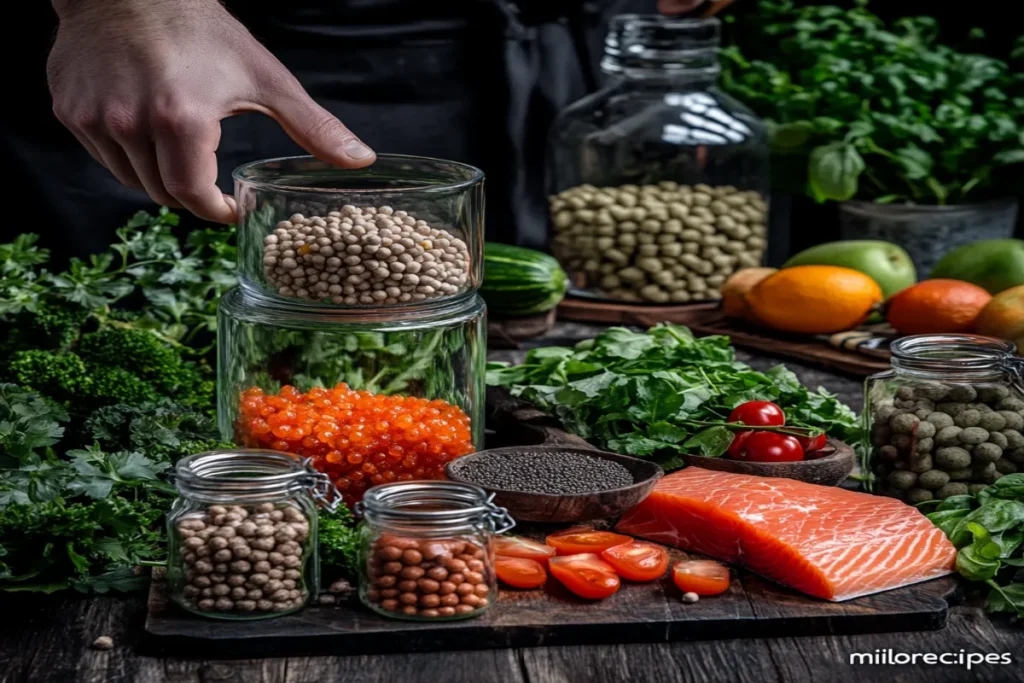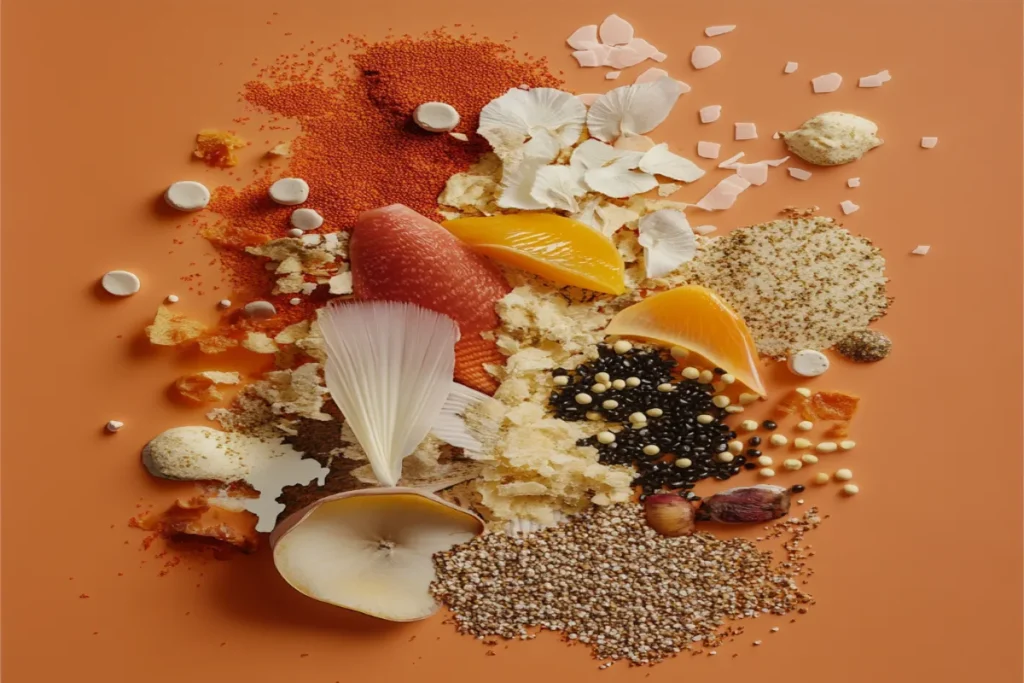Have you ever looked into your aquarium and felt a pang of responsibility for the vibrant lives swimming within? Just like we know the importance of feeding our families nutritious meals, the same principle applies to the fish we keep. Making your own homemade Fish Food Recipe not only ensures that your aquatic friends get the best nutrition possible but also allows you to connect with their needs on a deeper level.
The fresh ingredients you choose can make all the difference, steering clear of the fillers and preservatives often found in commercial options. Join me as we explore the world of creating healthy dinner options for your fish. Discover handy recipes that fit seamlessly into your routine, including some quick meal ideas for your household too!
Table of Contents
Importance of Homemade Fish Food

More and more aquarists are choosing homemade fish food. It offers many benefits. One key advantage is the ability to customize the ingredients for each fish’s needs. This can improve their health, color, and energy.
Benefits of Tailoring Meals for Your Fish
Homemade fish food can save you money, often by 20-50%. A balanced diet helps your fish grow and live longer. It can add up to 30% to their lifespan, depending on the diet’s quality.
Your fish need a mix of nutrients. Aim for:
- 30-40% protein
- 20-30% fats
- 20-30% carbohydrates
Feeding them 2-3 times a day helps avoid overfeeding. This keeps the water clean and healthy.
Fresh Ingredients vs. Commercial Options
Homemade fish food with fresh ingredients has more protein and fewer additives. Commercial foods might have unknown ingredients that harm fish health. Choosing homemade means your fish get the nutrients they need without fillers.
Using fresh ingredients creates a caring environment. It boosts your fish’s overall health and happiness.
Understanding Fish Dietary Needs

Knowing what your fish need to eat is key to keeping them healthy and happy. Each fish type has its own special diet needs. A good diet helps them grow, behave naturally, and stay healthy. Let’s look at what different fish need to eat and why some commercial foods might not be enough.
Nutritional Requirements of Different Fish Species
Different fish like to eat different things:
- Carnivores: Fish like betta fish and Pea Puffers need lots of protein. This is because protein is their main food source.
- Herbivores: Fish like plecostomus need to eat plants. Their bodies are made to get nutrients from plants.
- Omnivores: Fish like ricefish and rasboras eat both plants and animals. They need a mix of foods to stay healthy.
A good diet for fish has five main parts: protein, fats, carbs, vitamins, and minerals. It’s important to get the right mix. Too much protein can be bad, and too much fat can hurt their liver. Fish that don’t eat carbs well need food that’s right for them.
Common Deficiencies in Commercial Fish Food
Many fish foods don’t give fish everything they need. This can lead to health problems. Lack of vitamins can make fish grow slowly and feel weak. Minerals are important for strong bones and working well, but they need to be the right kind.
Using real foods like black soldier fly and krill can help fix some of these problems. Fish that eat plants and animals can get better color and energy from spirulina. Live, frozen, and freeze-dried foods are also good for fish that need more protein.
| Fish Type | Main Dietary Component | Common Health Issues from Deficiencies |
|---|---|---|
| Carnivores | High Protein | Growth retardation, weakened immune system |
| Herbivores | Plant-based nutrients | Digestive issues, stunted growth |
| Omnivores | Balanced diet | Nutritional deficiencies, reduced vitality |
Essential Ingredients for Homemade Fish Food

Making homemade fish food means picking the best ingredients for your fish. You need animal proteins, vegetable nutrients, and fish supplements. These help your fish stay healthy and happy.
Animal-Based Proteins
Animal proteins are key for fish, like carnivores. Fish fillets, shrimp, and squid give them amino acids. This helps their muscles grow and colors brighten.
Using Antarctic krill adds omega-3 fatty acids. This is good for their growth and health.
Vegetable Additions
Vegetables are important for a balanced diet. Peas, zucchini, and algae give fiber and vitamins. They help with digestion and prevent bloat.
Algae wafers add plant matter. This ensures your fish get all the nutrients they need.
Supplements and Additives
Adding supplements boosts the nutrition of your fish food. Omega-3 fatty acids and vitamins fill in any gaps. This makes your fish food even better for your fish’s health and life span.
Step-by-Step Guide to Preparing Homemade Fish Food Recipe
Making fish food at home is rewarding. It ensures your fish get nutritious meals. Start by gathering ingredients. Choose high-quality proteins like fish or shrimp, and add veggies like spinach or peas.
Chop these ingredients into small pieces for easier blending. Use a blender to mix them into a smooth paste. Add gelatin to help the mixture stick together. This makes the food easy to eat for your fish.
After blending, pour the mix into molds or containers. Chill it in the fridge to set. Once it’s solid, freeze it for later use. This method makes preparing fish food simple and keeps your fish healthy.
Popular Homemade
Exploring homemade fish food recipes can greatly improve your fish’s diet. You can find many recipes for different fish species. These recipes are not only nutritious but also easy to make. Here are three favorite recipes for your fish care routine.
Gelatin-Based Fish Food Recipe
This recipe mixes proteins and vegetables for a healthy meal. Mix cooked fish like haddock or salmon with mashed potatoes, fried onions, and gelatin. It’s a protein-rich diet that’s simple to prepare.
Frozen Fish Food Recipe Cubes
Frozen fish food cubes make feeding easy. Blend cooked fish, peas, and oats, then freeze in ice cube trays. Thaw and drop these cubes into your tank as needed. They offer portion control and quick meals.
Vegetable and Seafood Blend
This recipe combines vegetables and seafood for a diverse diet. Mix shrimp, spinach, and various vegetables in equal parts. It supports a balanced diet and adds flavor.
| Recipe | Prep Time | Cooking Time | Total Time |
|---|---|---|---|
| Gelatin-Based Fish Food | 25 minutes | Varies | Approximately 40 minutes |
| Frozen Fish Food Cubes | 20 minutes | Freezing time | Ready instantly after freezing |
| Vegetable and Seafood Blend | 15 minutes | 10 minutes | 25 minutes |
Tips for Feeding Your Fish Food Recipe
Feeding your fish right is key to their health and happiness. Using good fish feeding tips can make their lives better. It’s important to control how much food you give them. Only feed them what they can eat in a few minutes to prevent bad water and health problems.
In this section, you’ll learn about the best ways to feed different fish species.
Portion Sizes and Feeding Frequency
Different fish need different amounts of food. Most tropical fish do well with one or two meals a day. Young fish or those that burn energy fast need smaller, more frequent meals.
Watch your fish closely. If food is left over after a few minutes, cut back on the amount next time. Some people even fast their fish once a week to keep their digestive system healthy.
Carnivorous fish like bettas and cichlids do better with less but bigger meals. Herbivorous fish, like algae eaters, might need more plant-based foods. Finding the right portion size is important for their health. Check the fish food package for guidelines, but adjust based on your fish’s response.
Remember, each fish species has its own feeding needs. For example, bottom-dwellers need sinking food, while surface feeders prefer floating food. Watching how your fish behave can help you adjust their diet. This will make your aquarium a lively and healthy place.
Incorporating Easy Dinner Ideas with Fish Food Recipe
Adding fish to your weeknight meals can change your dinner routine. It brings quick, healthy, and tasty options to the table. Fish is easy to cook, making it great for when you’re short on time. Plus, it’s versatile, so you can make many different dishes that everyone will love.
Quick Meal Preparation and Cooking Tips
Here are some tips to make your meals quicker:
- Choose fast-cooking fish like salmon or shrimp, which are ready in 10 to 20 minutes.
- Use canned fish like tuna or sardines for even quicker meals. They’re full of omega-3s.
- Add herbs and spices to boost flavors without a lot of work. Simple marinades can make a big difference.
- Stick to easy cooking methods like grilling, baking, or sautéing. They’re healthy and easy to do.
Simple Recipes for Weeknight Dinners
Here are some delicious and easy fish recipes for weeknights:
| Recipe | Cooking Time | Main Ingredients |
|---|---|---|
| Brown Sugar Salmon | 15 minutes | Salmon, brown sugar, garlic |
| Garlicky Shrimp Alfredo Bake | 30 minutes | Shrimp, pasta, garlic, cream |
| Spicy Salmon Rice Bowls | 20 minutes | Salmon, soy sauce, sriracha, vegetables |
| Sheet-Pan Garlicky Shrimp & Veggies | 30 minutes | Shrimp, mixed vegetables, garlic |
| Coconut Shrimp Curry | 20 minutes | Shrimp, coconut milk, curry powder |
Switching to fish-based weeknight meals can make meal planning fun and healthy. You’ll enjoy tasty meals that fit your busy schedule and improve your family’s health.
Monitoring Fish Health and Adjusting Diet
Keeping an eye on your fish’s health is key to a good aquarium. Look for signs of illness like lethargy or dull colors. These could mean your fish need a diet change to stay healthy.
Watch how your fish react to new foods. A balanced diet is important. Too much food can harm your tank’s water quality. Feed them just enough so they eat it in 5-10 minutes.
Also, test your tank’s water often. Check for ammonia and nitrite levels and keep the pH right. Changes might mean you need to change the water or food more often. This way, your aquarium stays healthy and happy.
For more delicious recipes and kitchen inspiration, stick around and explore our other articles.

